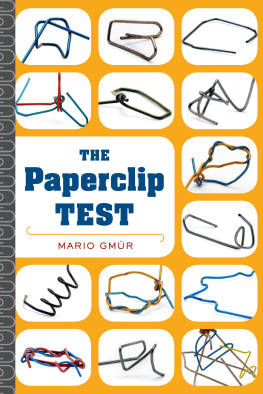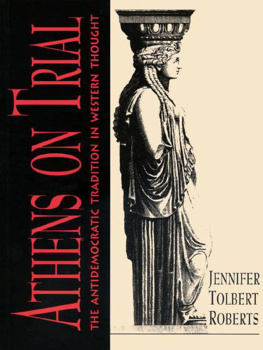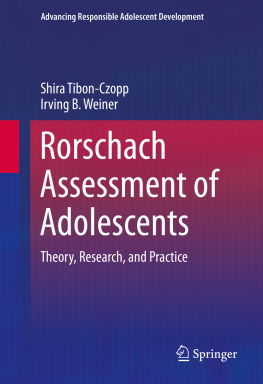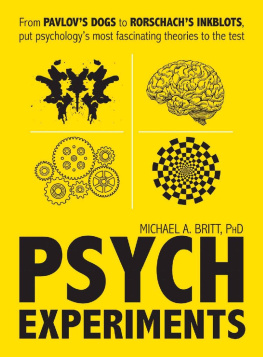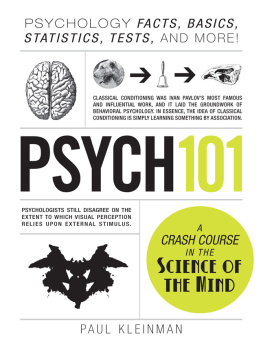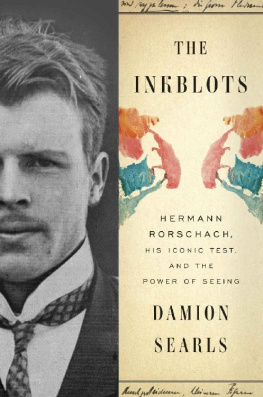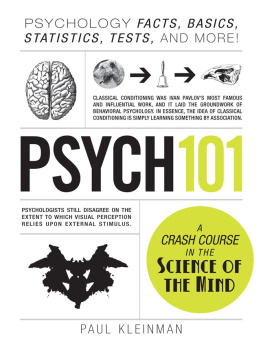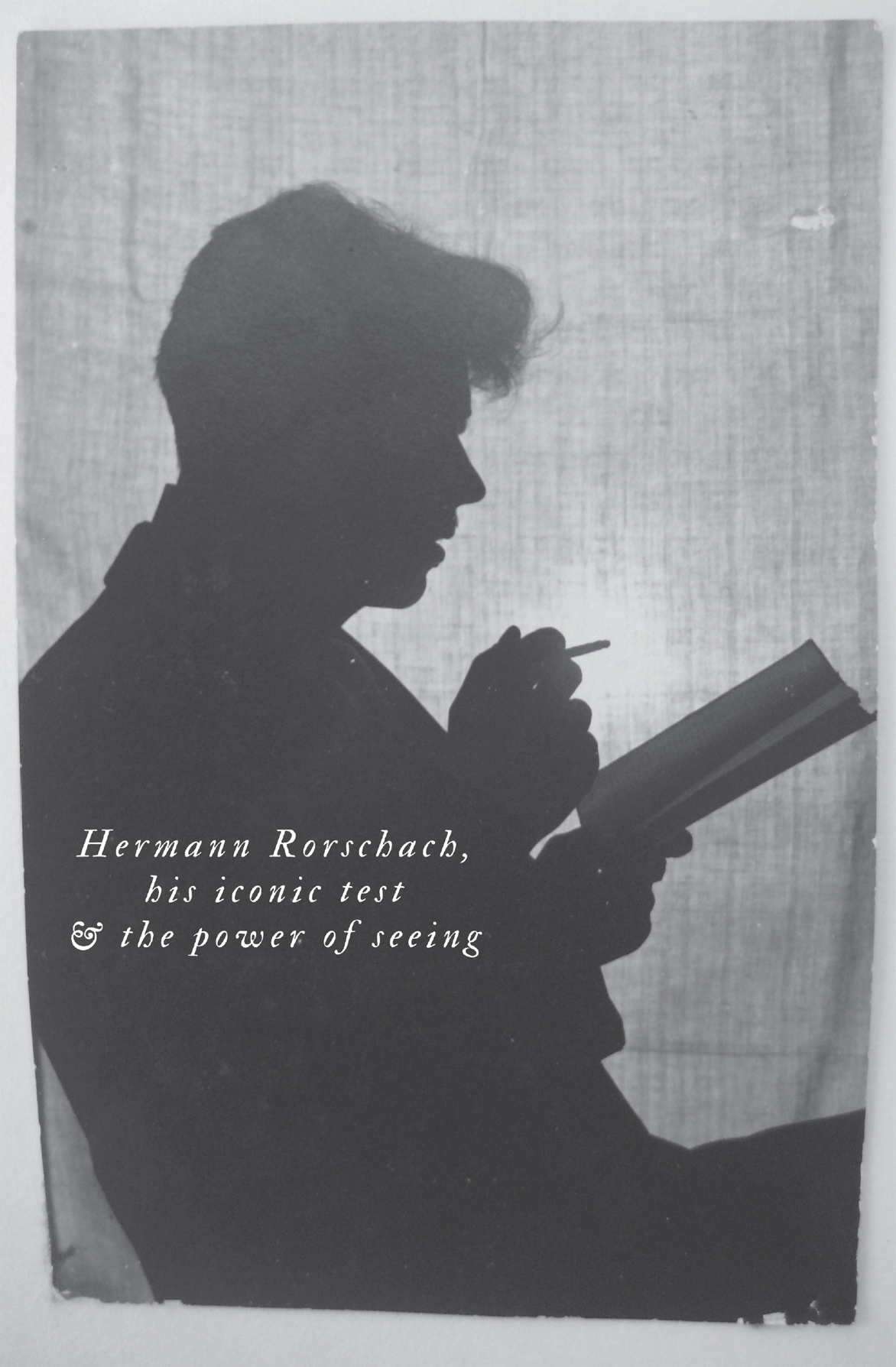The soul of the mind requires marvelously little to make it produce all that it envisages and employ all its reserve forces in order to be itself.... A few drops of ink and a sheet of paper, as material allowing for the accumulation and co-ordination of moments and acts, are enough.
P AUL V ALRY , Degas Dance Drawing
In Eternity All is Vision.
W ILLIAM B LAKE
AUTHORS NOTE

T HE R ORSCHACH TEST USES TEN and only ten inkblots, originally created by Hermann Rorschach and reproduced on cardboard cards. Whatever else they are, they are probably the ten most interpreted and analyzed paintings of the twentieth century. Millions of people have been shown the real cards; most of the rest of us have seen versions of the inkblots in advertising, fashion, or art. The blots are everywhereand at the same time a closely guarded secret.
The Ethics Code of the American Psychological Association requires that psychologists keep test materials secure. Many psychologists who use the Rorschach feel that revealing the images ruins the test, even harms the general public by depriving it of a valuable diagnostic technique. Most of the Rorschach blots we see in everyday life are imitations or remakes, in deference to the psychology community. Even in academic articles or museum exhibitions, the blots are usually reproduced in outline, blurred, or modified to reveal something about the images but not everything.
The publisher of this book and I had to decide whether or not to reproduce the real inkblots: which choice would be most respectful to clinical psychologists, potential patients, and readers. There is no clear consensus among Rorschach researchersabout almost anything to do with the testbut the manual for the most state-of-the-art Rorschach testing system in use today states that to want to ignore. We eventually chose to include some of the inkblots in this book, but not all.
It has to be emphasized, though, that seeing the images reproduced onlineor hereis not the same as taking the actual test. The size of the cards matters (about 9.5" 6.5"), the white space, the horizontal format, the fact that you can hold them in your hand and turn them around. The situation matters: the experience of taking a test with real stakes, having to say your answers out loud to someone you either trust or dont trust. And the test is too subtle and technical to score without extensive training. There is no Do-It-Yourself Rorschach, and you cant try it out on a friend, even apart from the ethical problem of possibly discovering sides of their personality that they may not want to reveal.
It has always been tempting to use the inkblots as a parlor game. But every expert on the test since Rorschach himself has insisted it isnt one. Theyre right. The reverse is true, too: the parlor game, online or elsewhere, is not the test. You can see for yourself how the inkblots look, but you cant, on your own, feel how they work.
INTRODUCTION

Tea Leaves
HAD REACHED THE final round of applying for a job working with young children, but, this being America at the turn of the twenty-first century, he still had to undergo a psychological evaluation. Over two long November afternoons, he spent eight hours at the office of Caroline Hill, an assessment psychologist working in Chicago.
Norris had seemed an ideal candidate in interviews, charming and friendly with a suitable rsum and unimpeachable references. Hill liked him. His scores were normal to high on the cognitive tests she gave him, including an IQ well above average. On the most common personality test in America, a series of 567 yes-or-no questions called the Minnesota Multiphasic Personality Inventory, or MMPI, he was cooperative and in good spirits. Those results, too, came back normal.
When Hill showed him a series of pictures with no captions and asked him to tell her a story about what was happening in each oneanother standard assessment called the Thematic Apperception Test, or TATNorris gave answers that were a bit obvious, but harmless enough. The stories were pleasant, with no inappropriate ideas, and he had no anxiety or other signs of discomfort in the telling.
As early Chicago darkness set in at the end of the second afternoon, Hill asked Norris to move from the desk to a low chair near the couch in her office. She pulled her chair in front of his, took out a yellow legal pad and a thick folder, and handed him, one by one, a series of ten cardboard cards from the folder, each with a symmetrical blot on it. As she handed him each card, she said: What might this be? or What do you see?

Rorschach Test, Card I
he asked were deflected:
Can I turn it around?
Its up to you.
Should I try to use all of it?
Whatever you like. Different people see different things.
Is that the right answer?
There are all sorts of answers.
After he had responded to all ten cards, Hill went back for a second pass: Now Im going to read back what you said, and I want you to show me where you saw it.
Norriss answers were shocking: elaborate, violent sexual scenes with children; parts of the inkblots seen as female being punished or destroyed. Hill politely sent him on his wayhe left her office with a firm handshake and a smile, looking her straight in the eyethen she turned to the legal pad facedown on her desk, with the record of his responses. She systematically assigned Norriss responses the various codes of the standard method and categorized his answers as typical or unusual using the long lists in the manual. She then calculated the formulas that would turn all those scores into psychological judgments: dominant personality style, Egocentricity Index, Flexibility of Thinking Index, the Suicide Constellation. As Hill expected, her calculations showed Norriss scores to be as extreme as his answers.
If nothing else, the Rorschach test had prompted Norris to show a side of himself he didnt otherwise let show. He was perfectly aware that he was undergoing an evaluation, for a job he wanted. He knew how he wanted to come across in interviews and what kind of bland answers to give on the other tests. On the Rorschach, his persona broke down. Even more revealing than the specific things he had seen in the inkblots was the fact that he had felt free to say them.
This was why Hill used the Rorschach. Its a strange and open-ended task, where it is not at all clear what the inkblots are supposed to be or how youre expected to respond to them. Crucially, its a visual task, so it gets around your defenses and conscious strategies of self-presentation. You can manage what you want to say but you cant manage what you want to see. Victor Norris couldnt even manage what he wanted to say about what hed seen. In that he was typical. Hill had learned a rule of thumb in grad school that she had repeatedly seen confirmed in practice: a troubled personality can often keep it together on an IQ test and an MMPI, do pretty well on a TAT, then fall apart when faced with the inkblots. When someone is faking health or sickness, or intentionally or unintentionally suppressing other sides of their personality, the Rorschach might be the only assessment to raise a red flag.



